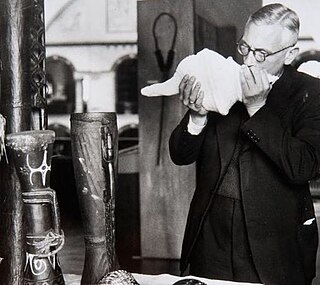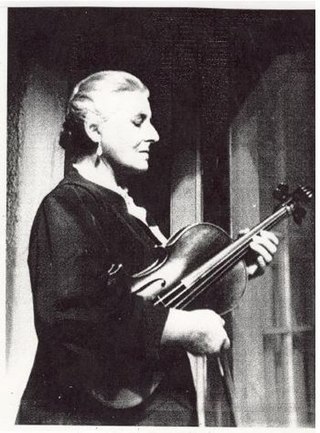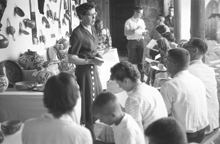
Anthropology is the scientific study of humanity, concerned with human behavior, human biology, cultures, societies, and linguistics, in both the present and past, including past human species. Social anthropology studies patterns of behavior, while cultural anthropology studies cultural meaning, including norms and values. A portmanteau term sociocultural anthropology is commonly used today. Linguistic anthropology studies how language influences social life. Biological or physical anthropology studies the biological development of humans.

Ethnomusicology is the multidisciplinary study of music in its cultural context, investigating social, cognitive, biological, comparative, and other dimensions involved other than sound. Ethnomusicologists study music as a reflection of culture and investigate the act of musicking through various immersive, observational, and analytical approaches drawn from other disciplines such as anthropology to understand a culture’s music. This discipline emerged from comparative musicology, initially focusing on non-Western music, but later expanded to embrace the study of any and all different kinds of music of the world.
Frederic Prokosch was an American writer, known for his novels, poetry, memoirs and criticism. He was also a distinguished translator.

Visual anthropology is a subfield of social anthropology that is concerned, in part, with the study and production of ethnographic photography, film and, since the mid-1990s, new media. More recently it has been used by historians of science and visual culture. Although sometimes wrongly conflated with ethnographic film, visual anthropology encompasses much more, including the anthropological study of all visual representations such as dance and other kinds of performance, museums and archiving, all visual arts, and the production and reception of mass media. Histories and analyses of representations from many cultures are part of visual anthropology: research topics include sandpaintings, tattoos, sculptures and reliefs, cave paintings, scrimshaw, jewelry, hieroglyphics, paintings and photographs. Also within the province of the subfield are studies of human vision, properties of media, the relationship of visual form and function, and applied, collaborative uses of visual representations.

The Arizona Historical Society (AHS) is a non-profit organization whose mission is to connect people through the power of Arizona's history. It does this through four regional divisions. Each division has a representative museum. The statewide divisions are as follows: Southern Arizona Division in Tucson, the Central Arizona Division in Tempe, the Northern Arizona Division in Flagstaff, and the Rio Colorado Division in Yuma. It was founded in 1884.

Field research, field studies, or fieldwork is the collection of raw data outside a laboratory, library, or workplace setting. The approaches and methods used in field research vary across disciplines. For example, biologists who conduct field research may simply observe animals interacting with their environments, whereas social scientists conducting field research may interview or observe people in their natural environments to learn their languages, folklore, and social structures.

Ethnochoreology is the study of dance through the application of a number of disciplines such as anthropology, musicology, ethnomusicology, and ethnography. The word itself is relatively recent and etymologically means "the study of ethnic dance", though this is not exclusive of research on more formalized dance forms, such as classical ballet, for example. Thus, ethnochoreology reflects the relatively recent attempt to apply academic thought to why people dance and what it means.

Elsie Ivancich Dunin is a dance ethnologist (ethnochoreologist), choreographer, professor and author specializing in folk dance from Croatia, Macedonia, and Romani (Gypsies) in Macedonia. Her studies focus on Croatian diaspora communities and associated sword dances in both Old and New World contexts. She is Professor Emerita of dance ethnology from the University of California at Los Angeles (UCLA) and is currently a dance research advisor with the Institute of Ethnology and Folklore Research in Zagreb, Croatia. Her two daughters are Teresa (T.J.) and Elonka Dunin.
Congress on Research in Dance (CORD) was a professional organization for dance historians in the United States and worldwide that was founded in 1964 and then merged in 2017 with the Society of Dance History Scholars to form the Dance Studies Association (DSA).
The Society for Ethnomusicology is, with the International Council for Traditional Music and the British Forum for Ethnomusicology, one of three major international associations for ethnomusicology. Its mission is "to promote the research, study, and performance of music in all historical periods and cultural contexts."

The Museum of Northern Arizona is a museum in Flagstaff, Arizona, United States, established as a repository for Indigenous material and natural history specimens from the Colorado Plateau.
The Visual Resources Association is an international organization for image media professionals.
The Herberger Institute for Design and the Arts at Arizona State University in Tempe, Arizona was created in 2009 by the merger of two existing academic units, the Katherine K. Herberger College of the Arts and the College of Design. The Arizona Board of Regents approved the merger on April 30, 2009. The Herberger Institute comprises five schools: the School of Art; the School of Arts, Media and Engineering; The Design School; The New American Film School; and the School of Music, Dance and Theatre. It also houses the ASU Art Museum.

Gertrude Prokosch Kurath (1903–1992) was an American dancer, researcher, author, and ethnomusicologist. She researched and wrote extensively on the study of dance, co-authoring several books and writing hundreds of articles. Her main areas of interest were ethnomusicology and dance ethnology, with some of her best known works being "Panorama of Dance Ethnology" in Current Anthropology (1960), the book Music and dance of the Tewa Pueblos co-written with Antonio Garcia (1970), and Iroquois Music and Dance: ceremonial arts of two Seneca Longhouses (1964), in the Smithsonian Institution Bureau of American Ethnology bulletin. She made substantial contributions to the study of Amerindian dance, and to dance theory. From 1958 to January 1972 she was dance editor for the journal Ethnomusicology.

Eleanor Campbell King (1906–1991) was an American modern dancer, choreographer, and educator. She was a member of the original Humphrey-Weidman company, where she was a principal dancer in the pioneering modern dance movement in New York City, then moving on to choreography and founding her own dance company in Seattle, Washington. She was a professor emerita at the University of Arkansas, where she taught from 1952 to 1971, before retiring to Santa Fe, New Mexico, to start a new course of study into classical Japanese and Korean dance. She choreographed over 120 dance works, and wrote extensively for a variety of dance publications. In 1948, she was named Woman of the Year in Seattle, and in 1986 was listed as a "Santa Fe Living Treasure", also receiving the New Mexico Governor's Artist Award. In 2000, her archive was recognized by the White House Millennium Council's "Save America's Treasures" program.

Joann Wheeler Kealiinohomoku (1930–2015) was an American anthropologist and educator, co-founder of the dance research organization Cross-Cultural Dance Resources (CCDR). She has written and/or edited numerous books and articles, including contributions on dance-related subjects to multiple encyclopedias, such as writing the entry for "Music and dance in the United States" in the Garland Encyclopedia of World Music. Some of her best-known works are "An anthropologist looks at ballet as a form of ethnic dance" (1970) and "Theory and methods for an anthropological study of dance" (1976). An associate professor of anthropology at Northern Arizona University, she was named professor emerita in 1987. In 1997, she received the first annual award for "Outstanding Contribution to Dance Research" from Congress on Research in Dance. In 2000, the CCDR collection was named by President Bill Clinton's White House Millennium Council, as something that needed to be preserved under the "Save America's Treasures" program.
Jason Baird Jackson is an American anthropologist who is Professor of Folklore and Anthropology at Indiana University Bloomington. He is "an advocate of open access issues and works for scholarly communications and scholarly publishing projects." At IUB, he has served as Chair of the Department of Folklore and Ethnomusicology and as Director of the Folklore Institute. According to the Journal of American Folklore, "Jason Baird Jackson establishes himself as one of the foremost scholars in American Indian studies today."

Adrienne Lois Kaeppler was an American anthropologist, curator of oceanic ethnology at the National Museum of Natural History at the Smithsonian Institution in Washington, DC. She served as the President of the International Council on Traditional Music between 2005 and 2013. Her research focused on the interrelationships between social structure and the arts, including dance, music, and the visual arts, especially in Tonga and Hawaii. She was considered to be an expert on Tongan dance, and the voyages of the 18th-century explorer James Cook.

Louise Lincoln Kerr was an American musician, composer, and philanthropist from Cleveland, Ohio. She wrote over 100 music compositions including fifteen symphonic tone poems, twenty works for chamber or string orchestra, a violin concerto, five ballets and incidental music, numerous piano pieces, and about forty pieces of chamber music. She was known as "The Grand Lady of Music" for her patronage of the arts. Louise Kerr helped to co-found and developed The Phoenix Symphony (1947), The Phoenix Chamber Music Society (1960), The Scottsdale Center for the Arts, The National Society of Arts and Letters (1944), Monday Morning Musicals, The Bach and Madrigal Society (1958), Young Audiences, The Musicians Club, and the Phoenix Cello Society. Kerr was also a benefactor to the Herberger School of Music at Arizona State University. She was inducted into the Arizona Women's Hall of Fame on October 21, 2004 and was nominated by conductor and musicologist Carolyn Waters Broe.

Katharine Bartlett (1907–2001) was an American physical anthropologist who worked from 1930 to 1952 as the first curator of the Museum of Northern Arizona, cataloging and organizing the museum's holdings, and then as the museum's librarian until 1974 and archivist until 1981. She participated in a survey of the Navajo Nation's reservation in the Little Colorado River basin and established the cataloging system used by the Glen Canyon Archaeological Project. She was a Fellow of the American Association for the Advancement of Science, a Fellow of the American Anthropological Association and a Fellow of the Society of American Archaeology, as well as the first Fellow of the MNA. Honored in an exhibit of the Smithsonian Institution in 1986 and a recipient of the 1991 Sharlot Hall Award for her contributions to Arizona history, she was posthumously inducted into the Arizona Women's Hall of Fame in 2008.













